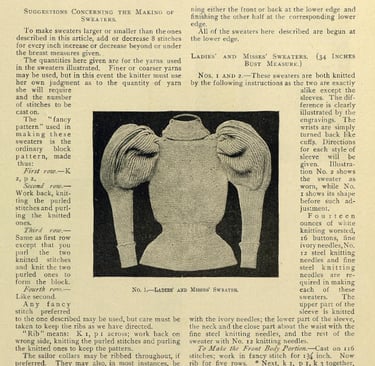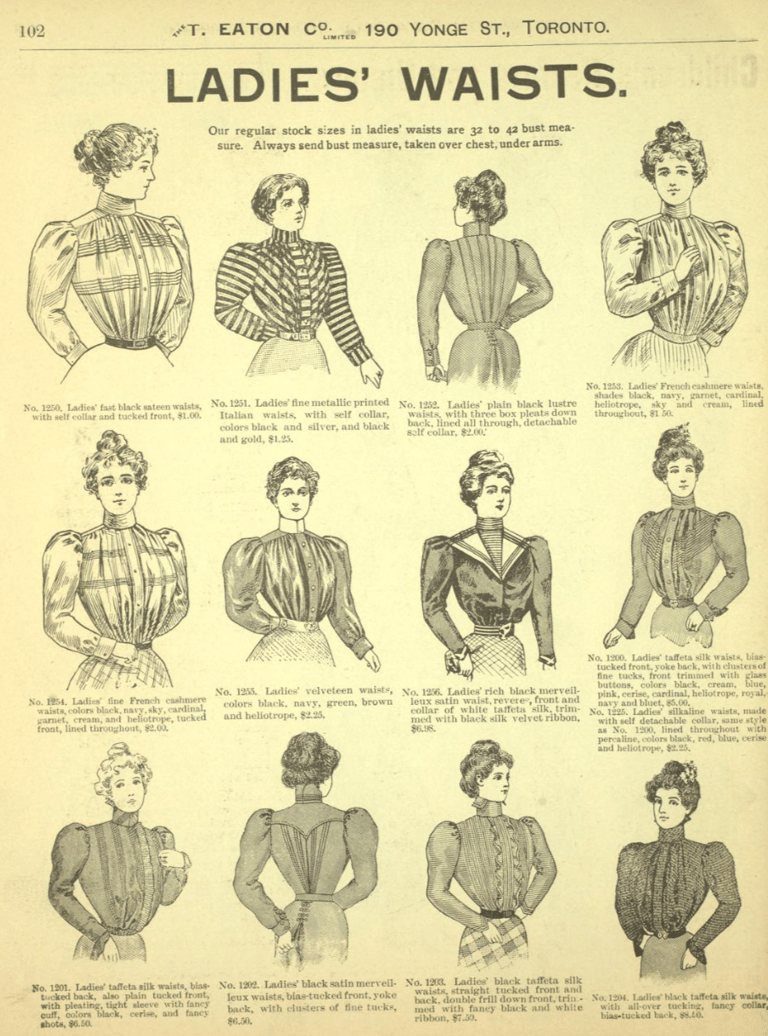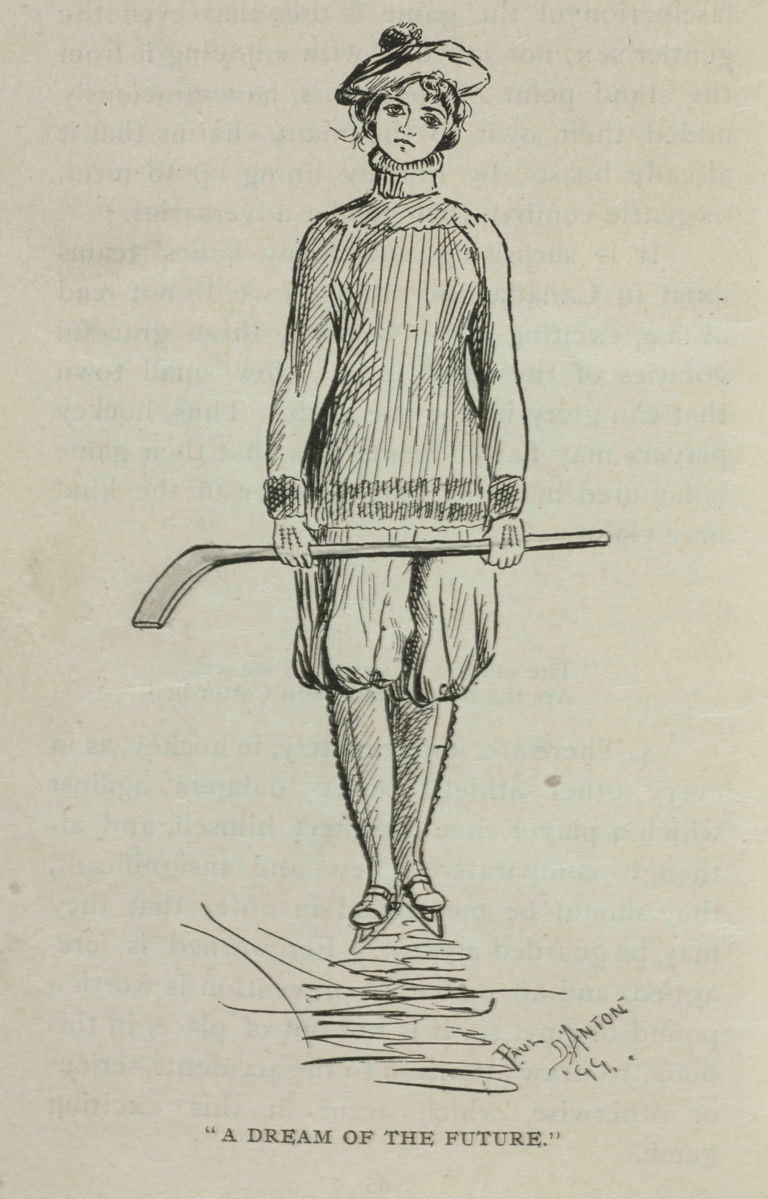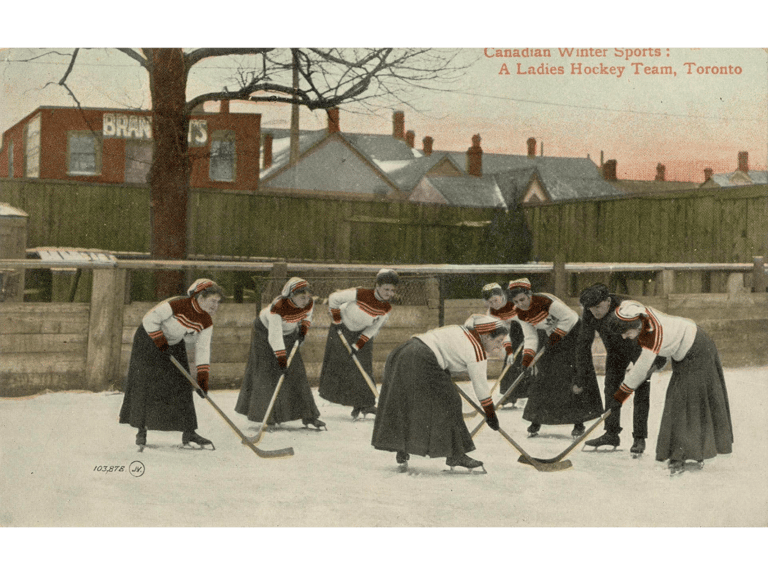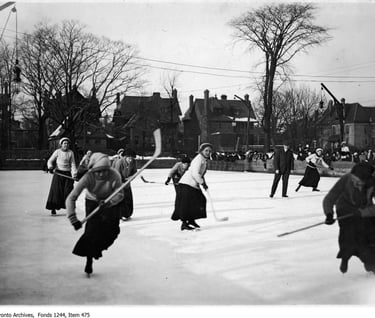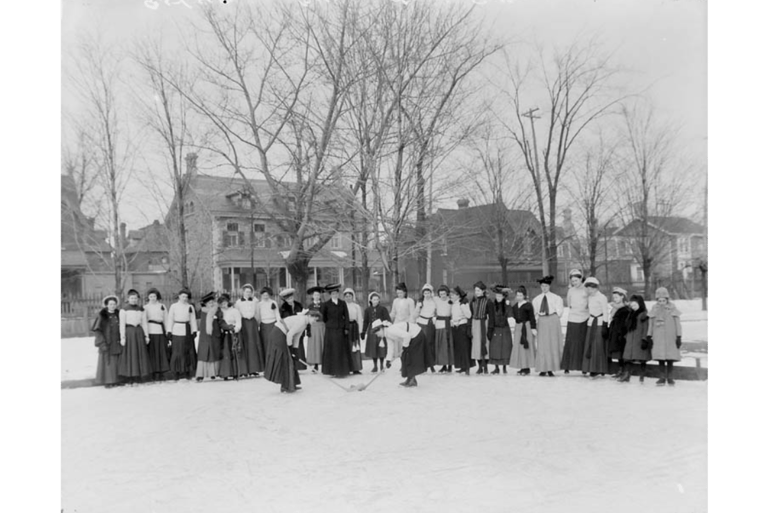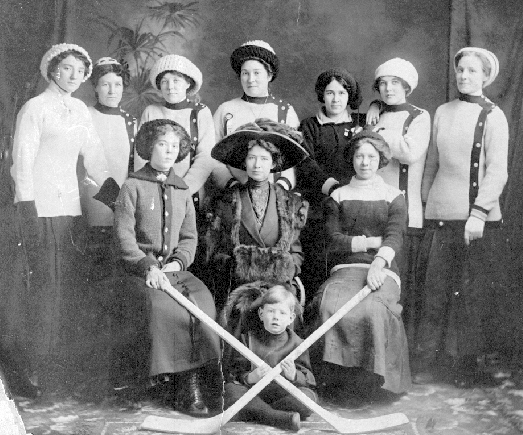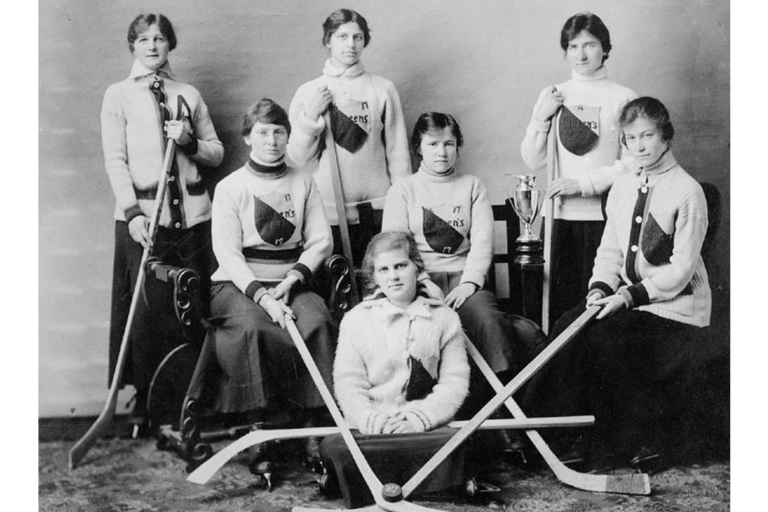The Hockey Sweater: 1890s-1920s
A brief history of women's sports clothes from the turn of the 19th century
COSTUMING
Spring 2023
Having created a Victorian cycling outfit already, I have been drawn to the exploration of women's sports clothing from the 1890s. The hockey jersey is one of the most recognizable items in Canadian culture and clothing history, but for women's teams, it didn't always start out this way. To further explore the hockey sweater, we'll have to break down its story into a few parts. In examining a collection of archival images from a variety of digitized collections, it is the goal of this post to examine the fashion and social history of a generally overlooked contribution to women's sports, and Canadian sports history at large. Virtually no research has been done on women's hockey sweaters in this time period, so the majority of this post is comprised of primary source analysis of knitting manuals, shopping catalogues and archival images. The method of analysis is along the same line as Julia Thomas' "The Evidence of Sight," wherein Thomas argues the importance of using photographs to reach new conclusions rather than supporting ones that already exist: "historians tent to treat them as mere illustrations, reproducing them in the text, the evidence is often used to illustrate conclusions that the author has already reached by other means, rather than to give new answers or to ask new questions." [1]
Figure One. Sweater pattern from Fancy and Practical Knitting, Butterick, 1897
Figure Two. Fashionable shirts from the Eaton's Catalogue, Toronto, 1899-1900
The sweater came to represent the idea of the New Woman, one engaged in politics, sports and suffrage. These early sporting women, especially cyclists, received intense criticism for their activities, and it’s likely the association with this ‘type’ of feminist rabble-rouser could be associated with the wearing of the sweater, and vice versa [3]. Mackintosh and Norcliffe address the growing phenomenon of women cycling in public spaces in their article “Flâneurie on bicycles: acquiescence to women in public in the 1890s.” It talks about the practice of “flaneurie,” to see and be seen and how the Bicycle Craze enabled women to be seen as sporting at the turn of the century. To apply it to this topic, the increase of women and sports in the 1890s, not just cycling, made them engage more publicly and outside of the home. Ann Hall also addresses this in her book The Girl and the Game: A History of Women’s Sport in Canada in the identification of ‘Mannish Maidens,’ establishing that while a certain degree of physical activity was encouraged, too much athleticism was unfeminine [4]. Among the list of acceptable sports according to an 1890 newspaper article was “horsemanship, walking, climbing, rowing, skating, lawn tennis, badminton, and golf,” with manly sports consisting of “cricket, soccer, rugby, grass hockey, rounders [...] lacrosse, football, and baseball,” no mention of hockey [5]. In Canada, the first (alleged) hockey game amongst women was in 1891, played in Ottawa at the Rideau Hall skating rink. Among the players was Lady Isobel Stanley, the daughter of Lord Stanley, and one of the most active proponents in the creation of the Stanley Cup for men’s hockey. A local reporter spotted the game and stated that the women “are very swift skaters and they can dodge with the puck to equal some of the best men players.” [6] A lady of Isobel’s standing not only supporting the game but being an active player neither situated it as a ‘feminine’ or ‘manly’ game, but one that women just played. In the 1899 book Hockey: Canada’s Royal Winter Game by Arthur Farrell, his description of women ‘hockeyists’ is present, though condescending. He describes the women’s teams as
Figure Three. "A Dream of the Future," originally from Hockey: Canada's Royal Winter Game by Arthur Farrell, 1899.
Figure 4. "Canadian Winter Sports: A Ladies Hockey Team, Toronto." 1909. TPL Digital Archives.
Figure 6. "Women Playing Hockey." 1912. City of Toronto Archives, Fonds 1244, Item 475.
The history of the women’s sweater is a rather recent one. Sweater-wearing started to become popular in the 1890s with the increase of women participating in leisure activities and sports. In these early years, sweaters weren’t commercially available like they are today, but one could knit one or commission a knitter for one. Knitting books like Fancy and Practical Knitting from 1897 have a sweater pattern specifically designed for “golf, cycling, etc.” (Fig 1) This early form of sportswear was fashioned after the popular silhouette of the 1890s, with a nipped waist and large gigot sleeves (Fig 2). This link was the feminine stylization of the sweater, as men had been wearing sweaters for a longer period, leading to women adapting this style for their own needs [2]. The sweater was the ideal garment for sports clothing - it was warm, attempting to be stylish and not as bulky as typical outerwear. In looking at photographs of sporting women from this time period, the sweaters they are wearing appear to be very similar to this style.
Figure 5. "Ottawa Ladies' College Group," March 1906. Library and Archives Canada, Item no. 95649.
Figure 7. "Rossland Ladies Hockey Team," 1906. Columbia Basin Institute 2285.0004.
Figure 8. "Group Hockey Team Portrait, Queen's University," 1917. Library and Archives Canada, Item no. 3386222
Figure 9. "Girls' Hockey Team," 1921. Library and Archives Canada, Item no. 3386153.
“The convincing, the clinching proof of fascination of the game is this, that even the gentler sex, not satisfied with enjoying it from the stand point of spectators, have graciously added their own, to the many charms that it already boasts, by bravely lining up to meet, in gentle combat, their tender adversaries. It is surprising how many ladies’ teams exist in Canada, and although we do not read of fast, exciting games between these graceful votaries of the sport, it is a slow, small town that glory in not one such. Thus, hockey players may flatter themselves that their game is honored in a way that no other of the kind may claim.” [7]
The women’s game was often displayed as a novelty, and while tournaments were held and the game became more popular and organized in the 1920s, it wouldn’t be until 1998 that a Canadian woman’s hockey team was allowed into the Olympics, nearly 100 years after the first documented game [8].
Even with the condescending and sometimes negative press, this didn’t stop women from competing and joining community and university teams, and the sweater was a key piece of the ‘hockeyist’ uniform from coast to coast. By comparing volumes of the T. Eaton’s Company catalogues we can see the increasing availability of styles as the 20th century emerges. The 1899 edition features no sweaters but a new, shorter skirt marketed towards the cyclist, though this type of skirt would be ideal for other types of physical activity [9]. At this point though, we do know that commercial patterns were available to knit your own. Moving nine years forward, the 1909 edition of the catalogue offers six sweater styles for women, advertised as ‘Coats.” The three models are inspired by different sporting activities: golfing, riding and skating [10]. At this time, the ninth edition of the popular Columbia Knitting Book would have been available for purchase. Originally published in 1901, this book was updated for over a decade with new styles. This particular edition has 18 knitting patterns for sweaters, from golf to automobile styles [11]. Moving into the Great War period, sweaters were well within the rotation of fashionable and sporting ladies' attire at this point. The 1913 catalogue features a dozen women’s sweaters and over two dozen men’s styles, with models posing with hockey sticks, running with their dogs or just in an outdoor scene [12]. To round out the focus time period, the 1920 catalogue features the largest selection with 25 styles and the most colours, diverging from the typical white, red or navy advertised in other volumes [13].
Archival images and sketches demonstrate the sweater style evolution as well. From handknits or commercially purchased sweaters to branded team gear. An 1899 sketch of a hockey player shows her in a knitted turtleneck sweater and tam o’ shanter, bloomers and knee-high gaiters (Fig. 3). Following nicely with the ‘new woman’ era of clothing and sportswear, this would have been a statement piece to any passersby with an ‘old fashioned’ outlook on women and sports. In images from the 1890s such as this sketch, and photographs from the early 20th century like “Canadian Winter Sports: A Ladies Hockey Team, Toronto,” we see a similar turtleneck style, with all the team members wearing the same striped jumper and matching toque (Fig. 4). The pullover style seems to have remained popular in hockey, with the cardigan starting to taking over in the 1910s, in sports and commercial styles. This image of the Ottawa Ladies’ College team shows a variety of upper garments (Fig 5). Younger girls, and likely spectators, appear to be wearing typical outerwear in the form of coats. The women on the team are wearing a lightly coloured pullover sweater with a darker coloured sash, likely matching the colour of their toques. Other teammates are wearing cropped jackets with no visible sweater, but still the sash. Overall, the majority of the sporting party in the image look like their clothes would suit an active lifestyle, I would be inclined to say ‘except for their skirts’ but this image from the City of Toronto archives shows a team in action, clearly unhindered by the length of the garments (Fig 6). On the West Coast, the Rossland Ladies Hockey Team sports buttoned cardigans with a side opening as their team uniform. This image from 1906, likely represents the transition from a pullover hockey sweater to the more practical cardigan style. Of the ten women pictured, only two are wearing pullover styles (Fig 7).
Outside of community teams, big universities like Queens, UofT, and McGill had women’s hockey teams. The sweater still remained a staple, but team branding through these university teams looks more like the iconic sports jerseys most are familiar with today (Fig 8). Community and university teams carved out a path for women’s professional hockey at the cusp of the 20th century, and while there was small evolution in styles, the hockey sweater was as present in these early years of women’s hockey, very much like the men’s teams. Moving into the 1920s, sweaters and uniforms become more practical, with padded protection, knickerbocker pants and tighter hats (Fig 9). This image of a team even features striped jerseys, reflective of the earlier 1909 style, and still a popular design element in contemporary hockey jerseys today.
The hockey sweater is an iconic piece of Canadian fashion history, just ask Roch Carrier, whose 1979 book titled The Hockey Sweater points to the garment’s fame. Women have been playing the game nearly as long as men have in Canada, and the history of their hockey sweaters, their game and the statement it made helped shape women’s hockey today - even if the sweaters look a bit different.
Endnotes
[1] Julia Adeney Thomas, "The Evidence of Sight," History and Theory THEME ISSUE 48: Photography and Historial Interpretation 48, no. 4 (2009), 156.
[2] Sydney Crabaugh, “Thank the Edwardians for Women’s Sweaters” Squid’s School of Vintage Knitting, August 10, 2022. Patreon Podcast, website, 42:15
[3] Phillip Gordon Mackintosh and Glen Norcliffe, “Flâneurie on bicycles: acquiescence to women in public in the 1890s”, The Canadian Geographer L:1 (2006), p. 18.
[4] Anne M. Hall, The Girl and the Game: A History of Women’s Sport in Canada, (Toronto: University of Toronto Press, 2020), 33.
[5] Hall, The Girl and the Game, 33-34
[6] Natasha Jamieson, “Women’s Hockey Herstory: 1890-1990,” Hockey Canada, April 7 2013. <https://www.hockeycanada.ca/en-ca/news/womens-hockey-herstory-1890-to-1990>
[7] Arthur Farrell, Hockey: Canada’s Royal Winter Game, (Montreal: C.R Corneil, Printer, 1899), 44-45
[8] Hall, The Girl and the Game, 59.
[9] T. Eaton Co, Eaton's Fall and Winter Catalogue 1899-1900, (Toronto: T Eaton Co, 1899), 3-5 <https://archive.org/details/eatons1899190000eatouoft/page/2/mode/2up>
[10] T. Eaton Co, Eaton’s Fall and Winter Catalogue 1909-1910, (Toronto, T Eaton Co, 1909), 34 <https://archive.org/details/eatons190900eatouoft/page/n45/mode/2up?view=theater>
[11] Anna Shumacker, The Columbia Book of Yarns: Containing a Manual of Knitting and Crocheting, (Philadelphia: Columbia Yarns, 1908 ed.), 125-163. <https://archive.org/details/columbiabookofya05schu/page/162/mode/2up>
[12] T Eaton Co. Eaton’s Fall and Winter Catalogue 1913-1914, (Toronto: T Eaton Co, 1913), 56a, 56b, 156-156b <https://archive.org/details/eatons19131400eatouoft/page/n63/mode/2up>
[13] T Eaton Co. Eaton’s Fall and Winter Catalogue 1920-1921, (Toronto: T Eaton Co, 1920), 84-88. <https://archive.org/details/eatons19202100eatouoft/page/n95/mode/2up>
Works Cited
Crabaugh, Sydney “Thank the Edwardians for Women’s Sweaters” Squid’s School of Vintage Knitting, August 10, 2022. Patreon Podcast, website, 42:15
Crabaugh analyzes the rise of women's sweaters at the turn of the 20th century. Through primary source analysis similar to the method of this post, she tracks the history of the sweater as a sports and fashion garment. She has a unique perspective as a knitwear historian and designer.
Farrell, Arthur Hockey: Canada’s Royal Winter Game. Montreal: C.R Corneil, Printer, 1899.
Farrell's book is one of the earliest published on the sport in Canada. As a primary source, this allows us to see how the game was perceived and talked about in the 1890s.
Hall, Anne M. The Girl and the Game: A History of Women’s Sport in Canada. Toronto: University of Toronto Press, 2020.
One of the few sources that discuss the history of women's sports in Canada. Navigating this history chronologically and thematically, Hall ties together the socio-cultural connections across sports.
Jamieson, Natasha “Women’s Hockey Herstory: 1890-1990,” Hockey Canada, April 7 2013. <https://www.hockeycanada.ca/en-ca/news/womens-hockey-herstory-1890-to-1990>
Jamieson's brief blog post sums up the early contributions to women's hockey. Published through the official Hockey Canada website, the platform allows this history to be canonized within Hockey's presence in Canadian culture.
Mackintosh, Phillip Gordon and Glen Norcliffe, “Flâneurie on bicycles: acquiescence to women in public in the 1890s”, The Canadian Geographer L:1 (2006).
Mackintosh and Norcliffe address the phenomenon of the Cycling Craze and the position of women as athletes. Their public reception as cyclists can be used to describe the experiences of other sports that straddle the line between acceptable and mannish.
Shumacker, Anna The Columbia Book of Yarns: Containing a Manual of Knitting and Crocheting. Philadelphia: Columbia Yarns, 1908 ed. <https://archive.org/details/columbiabookofya05schu/page/162/mode/2up>
The Columbia Book of Yarns is a much-loved and popular historical knitting manual. Due to the frequent editions, it can be used to track the institutional changes and trends in knitwear design in the early 20th century.
T Eaton Co Catalogues:
The following catalogues are useful as a primary source for their popularity in Canadian consumer culture. They give a distinctly Canadian perspective to fashion in the target time period.
T. Eaton Co, Eaton's Fall and Winter Catalogue 1899-1900. Toronto: T Eaton Co, 1899 <https://archive.org/details/eatons1899190000eatouoft/page/2/mode/2up>
T. Eaton Co, Eaton’s Fall and Winter Catalogue 1909-1910. Toronto, T Eaton Co, 1909 <https://archive.org/details/eatons190900eatouoft/page/n45/mode/2up?view=theater>
T Eaton Co. Eaton’s Fall and Winter Catalogue 1913-1914. Toronto: T Eaton Co, 1913. <https://archive.org/details/eatons19131400eatouoft/page/n63/mode/2up>
T Eaton Co. Eaton’s Fall and Winter Catalogue 1920-1921. Toronto: T Eaton Co, 1920. <https://archive.org/details/eatons19202100eatouoft/page/n95/mode/2up>
Thomas, Julia Adeney "The Evidence of Sight," History and Theory THEME ISSUE 48: Photography and Historial Interpretation 48, no. 4 (2009), 151-168
Thomas discusses the traditional uses of photographs as evidence and suggests alternative, more meaningful ways for the historian to analyze pictorial evidence.
Further Reading
Web Sources
Women's Hockey Life: An advocacy organization for "empowering women and girls in hockey." They detail the legacy of historical hockey pioneers which lead to women being active participants in the game today.
Rossland Museum: The Rossland Museum blog which has more information regarding the Rossland Ladies' Hockey Team.
Active History: A Canadian Public History blog which has a dedicated section to Sport History.
Archive.org: A collection of digitized archival documents from around the world. The website contains an extensive collection of Victorian and Edwardian knitting manuals.
Bond, Ellen. "Women's Hockey: She Shoots, She Scores!" Library and Archives Canada Blog, March 5 2020. <https://thediscoverblog.com/2020/03/05/womens-hockey-she-shoots-she-scores/>
Marshall, Susanne. "The Hockey Sweater," The Canadian Encyclopedia, July 2 2014. <https://www.thecanadianencyclopedia.ca/en/article/the-hockey-sweater>
McFarlane, Brian. Proud Past, Bright Future: One Hundred Years of Canadian Women's Hockey. Stoddart Publishing, 1994.
Scott, Shirley A. Canada Knits: Craft and Comfort in a Northern Land. Toronto/Montreal: McGraw-Hill Ryerson, 1990.


